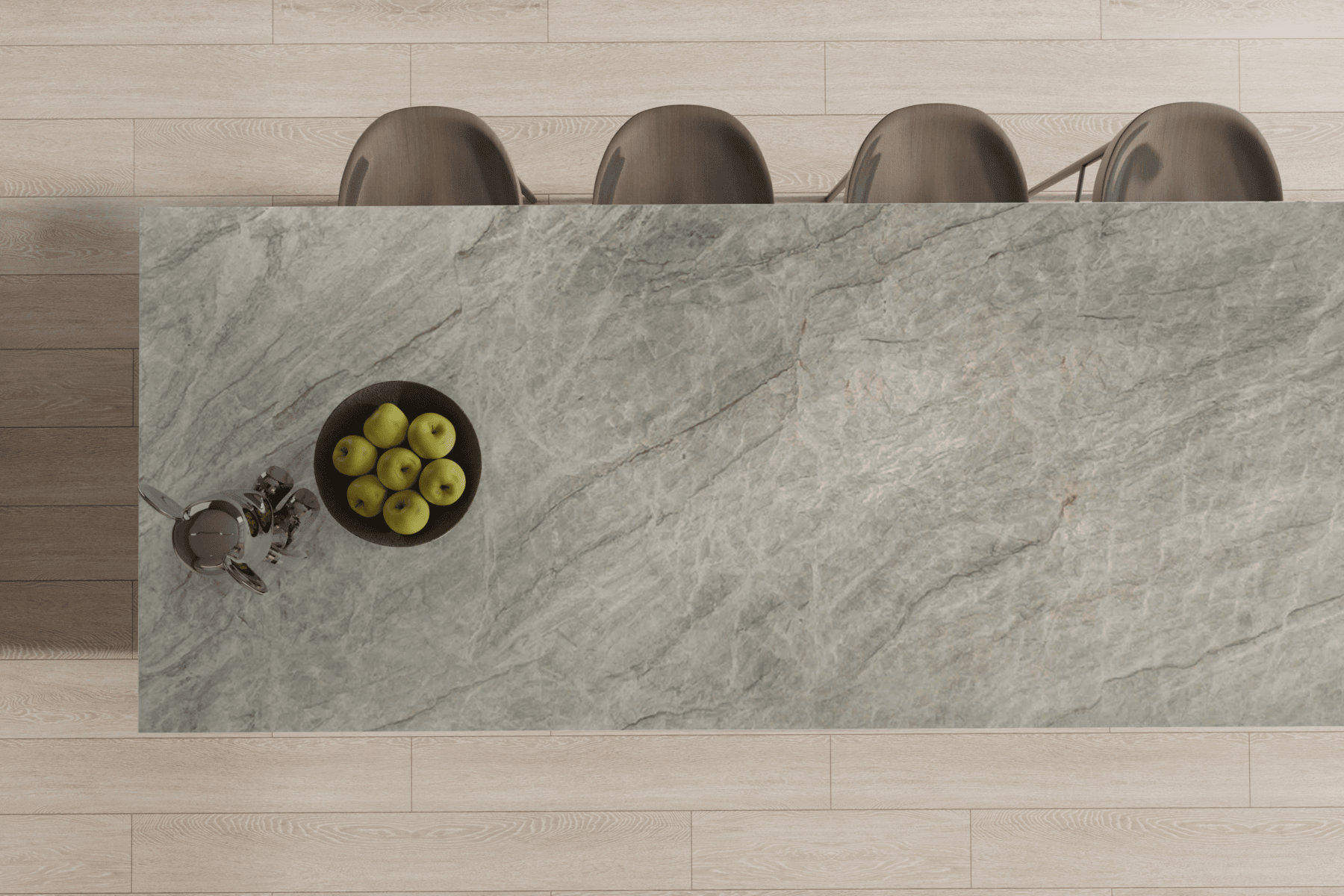In the world of interior design and construction, quartz slabs have become highly popular for their durability, aesthetic versatility, and easy maintenance. However, with growing awareness of health and environmental concerns, a new trend is emerging in the industry: Printed Quartz with Low Silica. This type of printed quartz offers the beauty of customized designs alongside the safety and sustainability of reduced silica content. In this blog, we will explore why Printed Quartz with Low Silica provides a competitive advantage, especially for suppliers entering markets like the U.S.
What is Printed Quartz?

Printed quartz refers to quartz slabs that use advanced digital printing technology to create intricate designs and patterns on the surface. These designs can replicate natural stone like marble or granite, or feature completely unique and customized patterns.
Printed quartz is an engineered material, made from a combination of natural quartz minerals, resins, and pigments. What sets printed quartz apart from traditional quartz is its ability to offer an extensive range of design possibilities while incorporating the added benefit of low silica.
You can learn about the full body of printed quartz here.
Why Low Silica Quartz is Important
Silica is a primary component of quartz, but it poses significant health risks when inhaled as fine dust, particularly during fabrication and installation. Exposure to respirable crystalline silica can lead to severe health issues, including lung diseases such as silicosis and lung cancer. This has become a growing concern in the manufacturing and construction industries.
Printed quartz with low silica addresses this problem by significantly reducing the amount of silica, minimizing health risks and ensuring a safer working environment. In markets like the U.S., where regulations surrounding silica exposure are tightening, low silica quartz is gaining traction as a safer alternative that does not compromise on quality or aesthetic appeal.
Advantages of Printed Quartz with Low Silica
1. Health and Safety Compliance
One of the primary advantages of printed quartz with low silica is its ability to meet strict health and safety regulations. In markets like the U.S., where health standards are becoming more stringent, offering low silica quartz allows suppliers to meet these demands, reducing the risk of silica-related illnesses in workers and consumers alike.
2. Aesthetic Flexibility
Printed quartz enables manufacturers to create highly customizable designs that cater to a wide range of styles. Whether the design goal is to replicate the natural veining of marble or create bold, contemporary patterns, printed quartz offers endless design possibilities.
The best part? Reducing low silica does not diminish the aesthetic quality. Customers can still enjoy the same level of visual appeal, making it a versatile material for any interior design project.
3. Durability and Performance
Despite the lower silica content, printed quartz retains its durability. Quartz is known for its hardness, typically ranking 7 on the Mohs hardness scale, making it resistant to scratches, heat, and stains.
By incorporating advanced resin technology and reducing silica, manufacturers ensure that printed quartz is as strong—if not stronger—than traditional quartz. This makes it a great choice for both residential and commercial spaces that require high durability and design flexibility.
4. Environmentally Friendly
In addition to reducing health risks, low silica printed quartz aligns with environmental sustainability efforts. By lowering the silica content, the environmental impact of mining and processing quartz is reduced. Opting for low silica quartz supports a more sustainable and responsible supply chain in the building materials industry.
Manufacturers can market printed quartz with low silica as both an eco-conscious and health-conscious product, appealing to customers who value sustainability alongside design.
Printed Quartz vs. Traditional Quartz Slabs
When compared to traditional quartz slabs, printed quartz with low silica offers several competitive advantages:
- Customizable Designs: Traditional quartz slabs are limited in terms of natural patterns, whereas printed quartz allows for customized designs tailored to specific aesthetic preferences.
- Health and Safety: Traditional quartz often contains a high concentration of silica, posing health risks to workers during fabrication and installation. Printed quartz with low silica offers a safer alternative, minimizing exposure to harmful silica dust.
- Marketability: In markets like the U.S., where regulations are tightening around silica exposure, low silica quartz gives suppliers a unique competitive edge by meeting safety standards while still delivering high-quality designs.
Applications of Printed Quartz with Low Silica
Printed quartz with low silica is suitable for a wide range of applications across residential, commercial, and industrial spaces:
- Kitchen Countertops: Homeowners can enjoy customized designs that match their style while benefiting from a durable, low-maintenance surface.
- Bathroom Vanities: The water resistance and durability of printed quartz make it a great choice for bathrooms, offering both beauty and functionality.
- Hospitality and Commercial Spaces: Hotels, restaurants, and office spaces can benefit from the aesthetic appeal and durability of printed quartz, while ensuring safety for installers and users.
Why Printed Quartz with Low Silica is the Future
As the demand for safer and more sustainable building materials grows, printed quartz with low silica is emerging as a key player in the quartz industry. It offers the perfect balance of customized design, durability, and health benefits.
For suppliers—especially those from countries like Vietnam and China—focusing on the benefits of low silica printed quartz will provide a competitive edge in markets like the U.S., where health and safety standards are increasingly strict.
Why Printed Quartz Slabs Can Replace Porcelain and Marble?
Printed quartz slabs can fully replace porcelain and marble in various interior and architectural applications. Here are the key reasons why printed quartz slabs can become a suitable alternative to both of these materials:
1. Higher Durability and Strength Compared to Marble
- Printed quartz slabs are more durable than marble thanks to their engineered composition, made from quartz powder combined with resin. Quartz has a high hardness rating, typically reaching 7/10 on the Mohs scale, while marble only scores between 3 and 5, making quartz more resistant to scratches and stronger under pressure.
- Marble is prone to scratches and damage from heavy impacts, whereas quartz offers superior hardness and durability, making it better suited for high-traffic areas like kitchen countertops, bathrooms, and flooring.
2. Better Water Resistance Compared to Marble and Porcelain
- Quartz slabs are non-porous, meaning they are completely water-resistant. In contrast, marble has a natural porous quality, making it more susceptible to water absorption and staining if not properly sealed.
- While porcelain also offers good water resistance, quartz remains easier to maintain as it doesn’t require frequent sealing like marble.
3. High Aesthetic Flexibility
- Printed quartz utilizes digital printing technology, allowing for customized patterns and colors, including the replication of natural stone patterns like marble, or entirely new and unique designs, which porcelain and marble cannot achieve.
- The design flexibility of printed quartz slabs enables them to fit a wide range of architectural styles, from classic to modern, meeting the aesthetic demands of diverse clients.
4. Easier Maintenance Compared to Marble
- Quartz is easier to maintain than marble, as it doesn’t require regular maintenance like polishing or sealing. Simple cleaning with soap and water is sufficient to keep it in top condition.
- Marble requires more extensive maintenance to avoid water absorption, staining, or scratching, which makes it less practical for high-use areas like kitchens or bathrooms.
5. Better Heat and Impact Resistance Compared to Porcelain
- Quartz slabs have better resistance to both heat and impact compared to porcelain, making them ideal for durable surfaces in areas like kitchen countertops or bars.
- While porcelain is heat-resistant, it can be more prone to cracking or breaking under heavy impact, whereas quartz is designed to withstand both heat and impact better.
6. Superior Color Retention and Customization Compared to Marble
- Printed quartz retains its colors over time without fading, as the colors and patterns are digitally printed directly onto the surface.
- Marble, being a natural material, may experience color variation over time, and its patterns can be affected by environmental factors. Quartz, on the other hand, with its digital printing technology, is not impacted by environmental conditions.
Conclusion
Printed quartz with low silica is more than just a building material—it’s a safer, more versatile, and sustainable solution for modern interior design. By offering aesthetic customization, durability, and the added advantage of reduced silica content, it is set to dominate the quartz market in the coming years.
For suppliers looking to enter the U.S. market, emphasizing the low silica feature of printed quartz will allow them to meet regulatory demands, promote worker safety, and position themselves as leaders in innovative quartz manufacturing.
Interested in learning more about the benefits of low silica printed quartz? Contact us today for more information!


